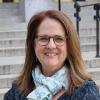Pope Francis' popularity began immediately after his March 13, 2013, election when he walked onto the balcony and humbly greeted the crowd in St. Peter's Square.
His appeal has been on a fast track ever since, causing many to speculate a possible "Francis effect" of increased numbers of Catholics going to church.
Although there has been anecdotal evidence of a resurgence of interest in the church since the pope's election, it may still be too early to see if this interest translates to new or returning members to the fold.
A Pew Research Center report released March 6 reiterates what most people likely realize: Pope Francis is immensely popular among U.S. Catholics -- so much so that eight in 10 have a favorable view of him. But according to the poll's results, the pope's popularity has not brought more people to Mass or the sacraments.
The polling -- conducted Feb. 14-23 among 1,821 adults nationwide that included 351 Catholics -- found no change in the number of Americans -- 22 percent -- who identify themselves as Catholic now and those who did prior to the election of Pope Francis. The data also found no change in self-reported rates of weekly Mass attendance among Catholics, which the report said remains at 40 percent.
The survey, "U.S. Catholics View Pope Francis as a Change for the Better," also did not find evidence that Catholics are volunteering or going to confession more often now than in the previous year, but it did find that seven in 10 U.S. Catholics see Pope Francis representing a major change in direction for the church. It also showed that during the past year, 26 percent of Catholics have become "more excited" about their Catholic faith and 40 percent of Catholics have been praying more often.
The poll, conducted by landline and cellphones, has an overall margin of error of plus or minus 2.6 percentage points.
The margin of error in this poll and others is one factor that makes it difficult to fully measure the "Francis effect," according to Mark Gray, director of Catholic polls and a research associate at Georgetown University's Center for Applied Research in the Apostolate, or CARA.
He noted in a blog in December that although Pope Francis' popularity could be bringing people back to church, it may be in smaller numbers than would cause a poll to fluctuate.
In the blog, he said, it's "really too early to know anything more than anecdotes," but he told Catholic News Service Feb. 27 that CARA will have more evidence to measure the pope's impact on the pews once it receives the 2013 data on sacramental practice from the Official Catholic Directory this summer. This data will enable CARA to make comparisons with previous years without margins of error since the numbers are directly from church records of baptisms, marriages, and other sacraments and rites.
Some observers told CNS that the pope's impact shouldn't be measured in returning Catholics, but in the restored image of the Catholic church since Pope Francis was elected and the number of Catholics who feel proud of their faith again. Others say the measurement of the pope's impact will take at least another year, and might be more noticeable after the synod on the family this fall.
Eileen Burke-Sullivan, associate theology professor at Creighton University in Omaha, Neb., said she has visited with Catholic lay leaders and deacons in recent parish presentations, where she has heard stories of adult children, inspired by the example of Pope Francis, wanting to come back to the church.
"I think there is a bounce right now," but the key is what they will find when they return: "Will it be different, or the same old same old?" she told CNS March 4.
She said parishes can act on the momentum generated by the pope by following his example of consultation.
Burke-Sullivan, who holds the Barbara Reardon Heaney Endowed Chair in pastoral liturgical theology at Creighton, said parishes should consider taking on serious studies and prayerful reflections of what they want to do differently to attract people and not drive them away and also how they can be more of a "field hospital" after battle as Pope Francis has described the church.
But even as local parish leaders -- and pollsters -- try to figure out what the pope's appeal means, church leaders don't deny that they have seen a ripple effect from the pope's example, which they say should ultimately point to God.
Bishop Rodolfo Wirz Kraemer of Maldonado, president of the Uruguayan bishops' conference, told CNS there has not been an automatic or immediate increase in Mass attendance since the pope's election. "There is a growth but it is a slow process."
"What I have seen is a renewal ... a greater interest of the people for the Gospel, for the church ... for Christ," he added.
Bishop Guilherme Werlang of Ipameri, president of the Brazilian bishops' commission for justice and peace, had a similar reaction.
"I think it's too early to state that there has been an increase in participation. What we can say is that at this first moment of enthusiasm, there has been a greater number of people at Masses ... but we want people to return to the church because of Christ not because of the pope."




